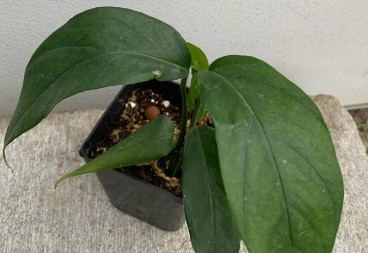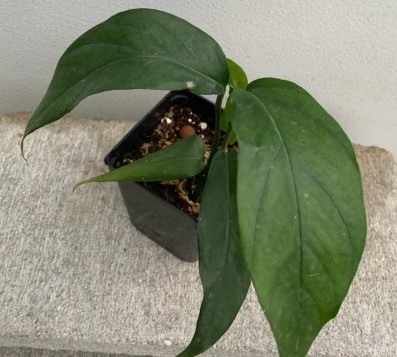Baltic blue pothos is an easy-to-care plant that you can add to your house plants to give your living space a special vigor and color. If you love indoor plants and pothos, too, do not hesitate to bring in the distinctive feel and appearance that comes with Baltic blue pothos. Like most pothos, baltic blue pothos plants are not as demanding. As such, nurturing them will not be a hard job.
| Botanical Name | Epipremnum pinnatum |
| Common Name | Baltic blue pothos |
| Plant Type | Perennial |
| Flower Color | Small yellow flowers |
| Size When Mature | 72- 120 inches long |
| Bloom Time | Spring |
| Sun Requirements | Full and Partial Sun indirect light |
| USDA Hardiness Zones | zone 9 to 11 |
| Soil PH Range | 5.5-6.5 |
| Soil Type | Slightly acidic, well-draining potting soil |
| Water Needs | Medium water requirements |
| Native Area | French Polynesia |
The Baltic blue pothos is making its way to several big box gardens and is fast becoming among the many popular and sought-after house plants. Their dark green leaves with blue undertones and fenestrations that appear on old leaves add unique beauty to your range of flowers.
If you are considering adding baltic blue pothos to your living space, keep reading to learn more about Baltic blue pothos and how to care for the plant.
Everything you need to know about Baltic blue pothos
Baltic blue pothos plants belong to the pinnatum species of the Epipremnum genus. In contrast, other pothos plants belong to the aureum species of the same genus. It is commonly referred to as pothos Baltic blue or Baltic form pothos.
Essentially, baltic blue pothos is a clone of the Epipremnum pinnatum and was created by the Costa farms. Unlike all pothos known to have originated from southern Asia, the Baltic pothos is believed to originate from French Polynesia.
Baltic blue pothos is a good houseplant that adds blue and deep green hues to your home. However, like all other pothos, it is toxic to pets and humans and should not be brought close to the mouth.
The most exciting thing about these attractive houseplants is that they are easy to care for, requiring minimal maintenance practices. Grow it in well-draining soils and away from direct sunlight. They need bright indirect sunlight to thrive.
When it comes to size, Baltic blue pothos plants vary in size depending on where it is growing. For instance, they grow to about 6 to 10 feet when planted indoors under ideal growing conditions and support items for them to climb on. When growing naturally in the wild, it can grow up to 60 feet long while climbing on nearby trees.
Indoor Baltic pothos may not grow to reach a point where they can start flowering. However, outdoor tropical Baltic blue pothos can produce small yellow flowers in spring after the plant matures.
How to care for Baltic blue pothos
Here is everything you need to know about growing and caring for Baltic blue pothos.
Light
Baltic blue pothos can grow in different light conditions but prefers areas receiving medium to bright indirect natural light.
Exposing baltic blue pothos plants to too much sunlight may seem okay but will make the leaves greener, preventing the occurrences of the blue hue. For the best results, position your baltic blue pothos plants near a window facing west or an obstructed east window, where it will basically receive an adequate amount of light.
Water and soil
The soil where your baltic blue pothos plants are growing should be left to dry out to at least half the soil depth between waterings. You can always carry out a soil moisture test before you water to avoid overwatering. Overwatering baltic blue pothos plants can stress them, resulting in yellow foliage and root rot.
Plant the baltic blue pothos in a well-draining general-purpose soil mix. The soil should have some composted forest products and perlite to enhance drainage. Good soil for Baltic blue pothos should be slightly acidic with a pH ranging from 5.5 to 6.5
Temperature requirements
Baltic pothos grows well at normal room temperatures ranging from 60 to 85 degrees Fahrenheit. They are tropical plants and may not tolerate cold conditions. However, some houseplant owners prefer to take pothos outside during the day and return them indoors when temperatures drop during the active growing season. The plants are well suited for USDA hardiness zone 9 to zone 11.
Pothos should never be left outside during winter. To keep them thriving, bring them indoors when temperatures drop below 55 degrees Fahrenheit. Instead, put them in a heated room or install LED grow lights at the top of the plant. In summer, the hot sunlight is fine for the plant as long as it doesn’t hit the plant leaves directly.
Fertilizer
The best fertilizer for baltic blue pothos is a balanced ratio NPK fertilizer. Apply at least two times every year to keep your plants healthy and happy. While diluting the fertilizer, follow the prescribed measurement units to avoid over-fertilizing or under-fertilizing the plant. If you wish to see your pothos grow rapidly, you can fertilize them more than twice every year.
Common diseases
The easy-to-care baltic blue pothos plants are commonly affected by Phytophthora root rot. This disease is caused by a fungus that develops in the soil when the soil gets damp over a long time. When the baltic blue pothos plants are attacked by root rot, their leaves usually wilt and turn yellowish. Always use a well-draining potting mix and water at good intervals to avoid root rot.
Baltic pothos propagation
Propagating Baltic blue pothos is quite easy. You can plant it in water, but most gardeners prefer planting the baltic blue pothos in well-drained soils.
For soil propagation, you should first take clean and disinfected pruners and cut a few healthy baltic pothos branches. Put the branches in water as you prepare a soil pot. Plant the pothos in the soil, ensuring at least two nodes are covered with soil.
If you choose to propagate in water, remove the lower leaves of the baltic blue pothos branch you had cut and put it in water. Ensure at least two nodes are inside the water. The water for growing pothos should be changed at least two times every week to prevent the formation of algae.


